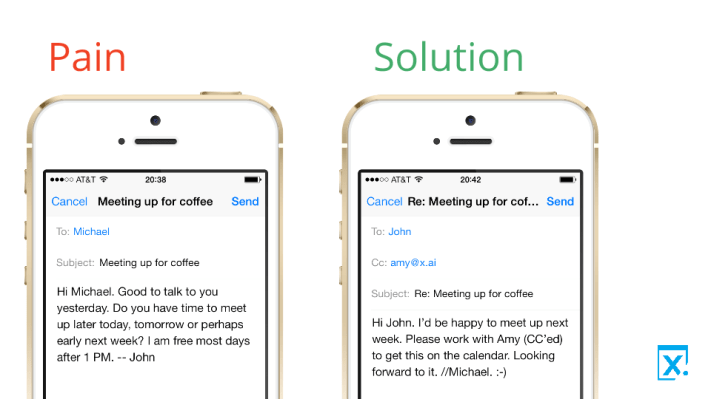While voice-recognition-powered virtual assistants like Siri, Cortana, Google Now and Amazon’s Echo continue to get more useful and reliable on the march to platform-dom, there is a parallel wave of development underway that has captured the public eye, where machine learning, artificial intelligence and natural language processing are getting corralled for more narrowly purposed means — by way of bots.
Today, a New York-based startup called X.ai — which has developed a bot that helps you arrange meetings with other people by way of a virtual assistant (‘Amy’ or ‘Andrew’) — announced that it has raised $23 million. The Series B funding will be used to take X.ai from a closed and free beta to a commercial product, and the startup also plans to hire more data scientists and other engineers.
X.ai is not releasing details of its valuation, but we understand from reliable sources that it is now around $100 million — a decent jump on the $40 million valuation the company had when it announced its Series A of $9 million in January 2015.
The funding is being led by Two Sigma Ventures, with other new investors including DCM Ventures and WorkBench Ventures. Also participating in this round were previous backers IA Ventures, Firstmark Capital, Softbank Capital / SBNY, Lerer Hippeau Ventures, Crunchfund (co-founded by TechCrunch founder Michael Arrington), and Pritzker Group Venture Capital.
Bots have been in the news of late for reasons good and bad. Microsoft’s Tay, a chatbot that launched with all positive intentions to learn how the youths talk today, had to go offline (with hiccups) after some cheeky types started to teach it racist slurs. Quartz turned a lot of heads with an app that was also based around a chat bot to serve you news stories.
While Tay lived on Twitter and Quartz’s news bot is in an iPhone app, X.ai was built around the premise that it should live on the platform that founder and CEO Dennis Mortensen said is the main one used today to arrange in-person and virtual meetings — email.
There are no other interfaces available now, but the next likely one will be what Mortensen believes is the next-most-popular medium for making plans — text messaging. Echo, Cortana and the rest may come later, he said. (Indeed, it’s getting a lot easier to integrate into these platforms, although Siri remains relatively closed off.)
In contrast to some of the rapid pace of added functionality that we’ve seen for the likes of Amazon’s Echo, X.ai has been a relatively slow developer. The startup first hit the market in May 2014, when it also announced a seed round, and in the last two years or so it has remained in a closed, invite-only beta.
It’s main — and indeed, only — product today is a “person” that exists as an email address for Amy or Andrew. When you want to make a plan to speak or meet with someone, you copy in Amy or Andrew. (Interesting side note: the actual humans who work at X.ai have ‘human’ in their email address, to contrast with amy@x.ai and andrew@x.ai… sign of the future?)
If it’s an in-person meeting, that bot will start to suggest places to meet and times to meet. If you’ve used Amy or Andrew before, they will start to learn about whether you are a Starbucks or Blue Bottle type, or if you prefer knocking one back with your contact at the local pub. Once a meeting is set, it is added into whatever calendar you use.
Interestingly, while some are clearly trying to establish platforms in this space — Amazon with Alexa and Echo being perhaps one of the most obvious examples — Mortensen believes there will be an increasing number of strong players that are just doing single services based around AI very well.
“The way I think this will play out is that you will have highly specialised and very intelligent vertical AIs,” he said, “not half-assed at everything but really good at one thing. We want, when you are thinking of things you might want to put on your calendar, that you think of nothing beyond cc’ing Amy.”
Of course, there are many more features that can grow out of that, for example Amy starting to suggest meetings rather than just reacting to your summoning her. But even without lots more functionality, the idea of doing one thing really well is clearly something that has resonated with its investors, too.
“Amy has scheduled more than 1,000 meetings for me in the past year. That’s a staggering number, and the benefits only compound within large organizations,” said Jonathan Lehr, Managing Director at WorkBench, in a statement. “There’s a certain magic to Amy that lights people up. I’m not sure I’ve seen a productivity product outside of Slack with this much potential, that delivers real ROI to the enterprise.”
X.ai is not disclosing how many users there are on the product today but Mortensen says there are “hundreds of thousands” with a very long waiting list as well.
Today, the product is free, and the plan is to keep a free tier in place as paid tiers get added in. The free tier will likely have the feature of arranging many meetings, but perhaps no longer unlimited.
“We don’t want to handicap the assistant,” he said.
The paid tiers will be “Dropbox-style”, Mortensen told me. That is to say, there will be a certain amount of data that will be given away with a very low barrier to entry on the paid product (‘$10 hypothetically’ is the price he told me). “The pricing will need to cement the fact that this is software,” he said.
